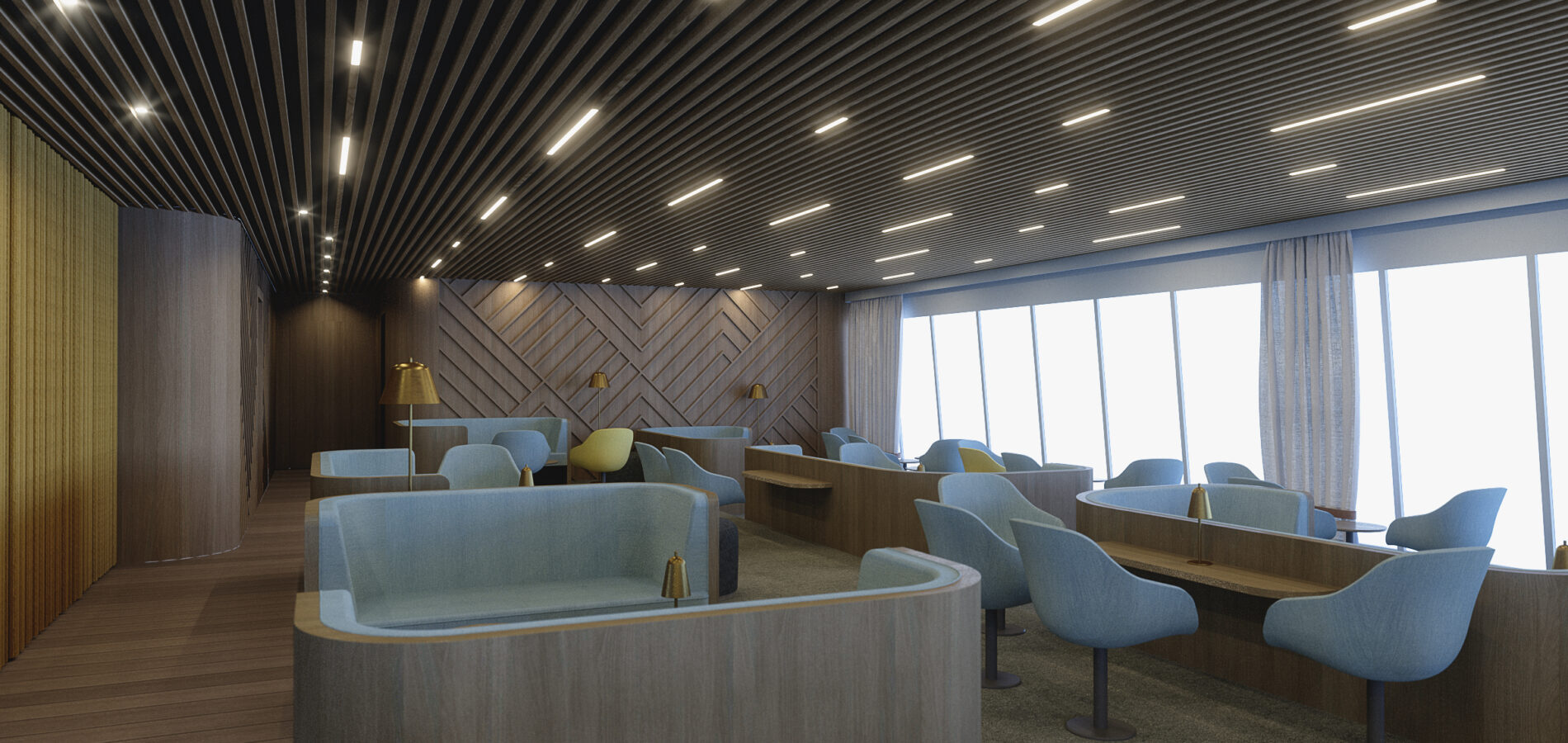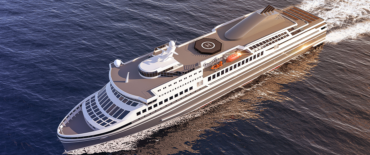Much of commercial design nowadays involves the specification of catalogue items. But might it be worth the expending of additional effort to create and specify unique designs, unavailable elsewhere? When an interior might possibly enjoy a life of at least a decade, the ‘one-off’ approach may pay dividends. Article from ShipPax by Bruce Peter.
For designers of commercial interiors nowadays, including passenger ship interiors, one of the year’s highlights is the Milan Furniture Fair. There, tens of thousands of chairs of every kind imaginable from manufacturers all over the world are displayed and it is possible to touch, poke, sit on and generally examine any number of candidates potentially suitable for the furnishing of new ferries and cruise ships. Contacts are made and re-kindled with key suppliers and lucrative contracts are discussed. What is shown in Milan a few years ago is most likely what you are now sitting on in the MSC Megalomania, the Costa Desperado, the Stena Connector or the Grimsby Seaways.
But what if instead you were to find yourself seated in a cruise ship or ferry interior on a chair that did not exist anywhere else in the world and that provided a completely unique experience for the posterior and eyes that was only available there – guaranteed? When one examines the history of shipboard design, as I have done for some years, one finds that most of the chairs in even quite mundane historic passenger ships were created as bespoke designs just for them. The same was true of the light fittings, door handles and many other small and tactile details. The recent Victoria and Albert Museum ‘Ocean Liners: Speed and Style’ exhibition showcased some superb examples from among the greatest vessels of the twentieth century. In my home, meanwhile, I have a small collection of Danish chairs from ship interiors of the 1930s-70s period, each one of which was a unique design for a particular project. The ones for DFDS’s ENGLAND of 1964, for example, are slightly different from those made for the WINSTON CHURCHILL of 1967 – though my own favourite is a gorgeous and supremely comfortable armchair with a winged back designed by the architect Kay Fisker for the KRONPRINS OLAV of 1937; over eighty years later, it remains a graceful and striking object – and probably now utterly unique in the world.
Non-places and more non-places
It is questionable how many passengers back in the day realised that they were travelling in environments that were tailored by their designers down to the last detail – but certainly enough people nowadays are bored with what the French anthropologist Marc Auge has described as ‘non-places’, by which he means the ceaselessly derivative commercial, retail and transport environments one is funnelled through, the obverse of ‘places’ created properly to occupy and feel at ease. Endless repetition of variations of the same banal elements have, he has argued, become a cause of ennui and so, for travel providers, it can only be a good thing to at least attempt to make a virtue of providing one-off and bespoke experiences. At least some users will appreciate the effort being made to be memorable instead of mundane and, besides, that ‘some’ irrelude the ones most likely to be the opinion-formers whose taste others are encouraged to follow.
Studio b33 – a fresh approach
It is against this context of homogenisation that a new and speculative Danish entrant in the ship interiors sector, the Copenhagen-based multi-disciplinary design collective Studio b33, is seeking to make a difference and to reassert a new variation on the old and largely abandoned Danish tradition for crafted interiors with unique, bespoke furnishings.
Led by the furniture lighting and product designer Rikke Hagen, the b33 group also includes the Danish furniture designers Hee Welling, Steffen Juul and Icelandic Gudmundur Ludvik, Spanish-born designer Mario Martinez, the lighting designer Øivind Slaatto, the British landscape architect Lauren Parsons and the Danish architect Karin Lund. The group became involved with ship interiors in 2018 from Rikke Hagen’s inspiring coffee talks with Finn Wollesen, Knud E. Hansen’s Managing Director. Along with the company’s Head of Interiors, Francesca Arini, they decided that a radical alternative to the ship interior design mainstream might find at least a niche in the international market.
In April 2019, visualisations of various interiors designed by b33 for both an Arctic exploration cruise ship and a Mediterranean ro-pax ferry were shown as a major part of Knud E. Hansen’s display at the Seatrade passenger ship-ping industry trade exhibition in Miami. This was designed by Hagen, Welling, Slaatto and Ludvik and featured unusual and potentially easily recyclable mate-rials for furniture and finishes such as cork, eelgrass, and fish skin. (It might be tenably argued that there is a tangential relationship between this approach and the one underpinning so-called ‘New Nordic Cuisine’ in which unexpected items are likewise featured.) Studio b33’s mock-up attracted considerable attention and, of course, just like the interiors designed long before by Kay Fisker and others, it contained only bespoke items. Of course, being unique and bespoke, its contents would actually be least likely ever to require recycling and would be more probably instead eventually to enter the collectibles market. Studio b33’s neat detailing and rather minimalist but high-quality content may indeed find a niche in the passenger shipping industry and similar interiors may in future be designed by them for real vessels.
The question is whether any shipowner in the cruise or ferry sectors would dare follow the lead of Viking Line, Celebrity Cruises or Virgin Voyages in commissioning another designer with no previous references in the shipping industry. The success of the interiors of vessels such as VIKING GRACE and CELEBRITY EDGE would seem to suggest that fresh thinking can only be beneficial and the creation of unique elements, all the better still.
Images

















